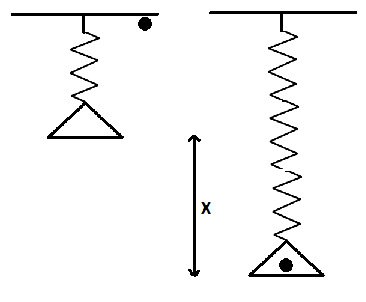Question
In: Physics
A massless pan hangs from a spring that is suspended from the ceiling. When empty, the...
A massless pan hangs from a spring that is suspended from the ceiling. When empty, the pan is 53 cm below the ceiling. If a 105 g clay ball is placed gently on the pan, the pan hangs 60 cm below the ceiling. Suppose the clay ball is dropped from the ceiling onto an empty pan. What is the pan's distance from the ceiling when the spring reaches its maximum length?
Solutions
Expert Solution
Note: Using the value of g (acceleration due to gravity) = 98 cm/s^2
Under the weight of clay ball, the spring extends by 7 cm (60 cm - 53 cm).
Balancing forces to calculate the value of k (spring constant)

Now, when the clay ball is dropped on the pan, the pan will stretch the spring untill the total kinetic energy is not converted into the potential energy. (See image)

Net height fallen by the ball = 53 cm + x cm = (53+x) cm
maximum extension in the spring = x cm
Let the potential energy at the ceiling is assumed to be zero.
Since, all the forces acting (spring + gravitation) is conservative, we can conserve mechanical energy between the initial and final configuration.




Solving, we get

Related Solutions
A massless spring hangs from the ceiling with a small object attached to its lower end....
A massless spring hangs from the ceiling with a small object attached to its lower end....
A spring with spring constant 14 N/m hangs from the ceiling. A ball is attached to...
A spring with spring constant 20 N/m hangs from the ceiling. A ball is attached to...
A spring hangs from the ceiling. A block of 0.450 kg is tied to the other...
A mass hangs from the ceiling by a spring. It takes the mass 700 ms to...
1. A mass weighing 10 lbs. is attached to a spring suspended from the ceiling. The...
A 200 g mass hangs from a massless spring (k = 10 N/m). At t =...
1. A 50-cm-long spring is suspended from the ceiling. A 230g mass is connected to the...
**A crate with a mass of 45 kg is suspended from a massless rope that runs...
- A conducting metallic spherical shell of inner radius a and outer radius b has a net...
- 3b. Describe the versatility of the glucose phosphate molecule. 3b. How do plants utilize this molecule?...
- A cross-country pipeline transports crude oil at a rate of 500,000 barrels per day. The pressure...
- Today I read articles and texts about Dirac monopoles and I have been wondering about the...
- The equilibrium constant (KP) is 0.16 at a particular temperature for the reaction: N2O4(g) ⇌ 2NO2(g)...
- Why have we not seen a US-based terrorist organization established with the goal to see the...
- Write a complete C++ program that prompts the user for the price of the prix fixe...
 genius_generous answered 1 month ago
genius_generous answered 1 month ago